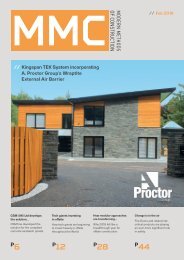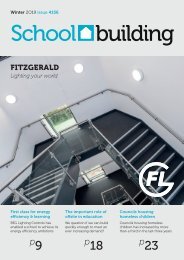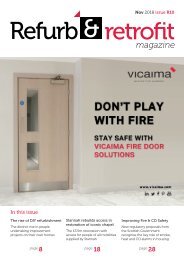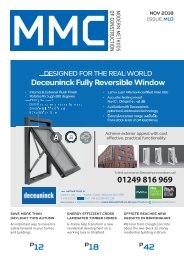You also want an ePaper? Increase the reach of your titles
YUMPU automatically turns print PDFs into web optimized ePapers that Google loves.
...All fire doors must<br />
be signed correctly<br />
so users know how<br />
they should be used.<br />
They should be<br />
clearly visible, easy<br />
to read and<br />
understand quickly,<br />
which is crucial in<br />
the event of an<br />
emergency...<br />
doorset design. If smoke seals are fitted, they<br />
should give an even contact with the floor<br />
but not interfere with the closing action of<br />
the door.<br />
Door Furniture<br />
Check door lever handles for smooth<br />
operation and that they freely return to<br />
horizontal positions. If they don’t, there<br />
could be a problem opening the<br />
door in the event of an<br />
emergency, or the door<br />
closing correctly to<br />
maintain fire integrity.<br />
Check that pull handles are<br />
securely fixed.<br />
Exit Devices<br />
If fire doors are on an escape<br />
route, they must be able to<br />
open without keys in the<br />
direction of escape and must be<br />
able to be easily operational.<br />
Exit devices such as panic bars or<br />
emergency exit hardware must<br />
function correctly so that people<br />
can immediately exit through the doorway<br />
when required. Check that fixings are tight on<br />
the device, the bolts, and the strikes, and that<br />
the door opens freely when the exit device is<br />
actuated.<br />
Hinges<br />
Hinges should be certified with a CE st<strong>amp</strong> or<br />
the BS EN 1935 grade 13 marking. All fire<br />
doors must have a minimum of three hinges<br />
per leaf and all screws must be tight and<br />
hinges should be free of metal fragments and<br />
oil leakage.<br />
Locks & Latches<br />
The latch or deadbolt should engage fully<br />
with the strike plate. If the door does not<br />
latch fully to the door frame, smoke and<br />
flame could escape around the door, which<br />
can cause visibility and breathing problems<br />
during a fire and potentially allow the fire to<br />
spread.<br />
Door Closers<br />
Check that the closer is<br />
securely fixed to the<br />
door and frame and that<br />
there are no visible<br />
signs of damage or<br />
leaking oil from the<br />
closer. The closer<br />
should hold the door<br />
firmly in the frame<br />
when unlatched.<br />
Open the door to a 5°<br />
angle, or to 75mm, and<br />
release; the door should<br />
close fully into the<br />
frame and engage the<br />
latch. If hung in pairs,<br />
open both doors; they<br />
should close in line if<br />
they are both opened<br />
and released together.<br />
Hold-Open Devices<br />
Hold-open devices, such as electro-magnetic<br />
closers, are the only way fire doors can be<br />
held open legally. They should release the<br />
door immediately when the fire alarm is<br />
sounded and close the door fully into the<br />
frame.<br />
Signage<br />
All fire doors must be signed correctly so<br />
users know how they should be used. They<br />
should be clearly visible, easy to read and<br />
understand quickly, which is crucial in the<br />
event of an emergency.<br />
Door Seals<br />
As smoke spread is an even greater threat to<br />
life and property than flames, fire doors must<br />
be fitted with intumescent seals to stop the<br />
ingress of smoke around the door edges. The<br />
seals should be well-attached inside the<br />
groove cut into the door or the frame. Make<br />
sure that they are in good condition and<br />
specified to the fire rating and function of<br />
the fire door.<br />
Glazing & Glass<br />
Glazing in fire doors is an important safety<br />
measure as it lets people see potential<br />
hazards, but it can create a point of<br />
weakness. Make sure that intumescent<br />
seals attached to the glass and beading<br />
are continuous and free from damage,<br />
as it’s their job to hold the glass firmly in<br />
place and prevent fire and smoke from<br />
passing through. Safety glass must be<br />
used in glazing panels below<br />
1500mm from the bottom of the<br />
door and if glass is at any time<br />
replaced it must be fire-rated.<br />
Make sure you check for a kite<br />
mark on the glass.<br />
If fire doors do not meet all<br />
of these criteria, then they<br />
may not function correctly in<br />
the event of a fire. That’s why it’s so<br />
important to carry out these simple checks –<br />
they could help you save lives.<br />
If you suspect that your fire doors do not<br />
meet the required standards it’s important to<br />
seek professional advice.<br />
www.allegion.com/uk/firedoorsafety<br />
<strong>November</strong> 20<strong>17</strong> R6 Refurb retrofit<br />
magazine<br />
<strong>17</strong>

















